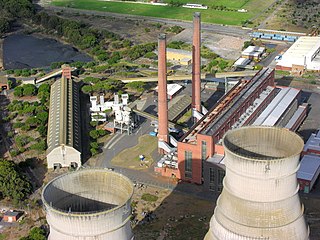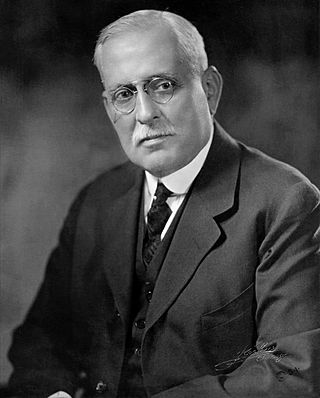
Electricity generation is the process of generating electric power from sources of primary energy. For utilities in the electric power industry, it is the stage prior to its delivery to end users or its storage, using for example, the pumped-storage method.

A power station, also referred to as a power plant and sometimes generating station or generating plant, is an industrial facility for the generation of electric power. Power stations are generally connected to an electrical grid.

Samuel Insull was a British American business magnate. He was an innovator and investor based in Chicago who helped create an integrated electrical infrastructure in the United States. Insull created holding companies that purchased utilities and railroads. Insull was responsible for the building of the Chicago Civic Opera House in 1929. Due to the Great Depression, his vast Midwest holding company empire collapsed, and he was accused of profiting personally by selling worthless stock to unsuspecting investors who trusted him because of his position and reputation. Following a seven-week trial, he and 16 co-defendants were acquitted of all charges after two hours of jury deliberation.
Commonwealth Edison, commonly known by syllabic abbreviation as ComEd, is the largest electric utility in Illinois, and the primary electric provider in Chicago and much of Northern Illinois. Its service territory stretches roughly from Iroquois County on the south to the Wisconsin border on the north and from the Iowa border on the west to the Indiana border on the east. For more than 100 years, Commonwealth Edison has been the primary electric delivery services company for Northern Illinois. Today, ComEd is a unit of Chicago-based Exelon Corporation, one of the nation's largest electric and gas utility holding companies. ComEd provides electric service to more than 3.8 million customers across Northern Illinois. The company's revenues totaled more than $7 billion in 2023.

Southern California Edison (SCE), the largest subsidiary of Edison International, is the primary electric utility company for much of Southern California. It provides 15 million people with electricity across a service territory of approximately 50,000 square miles.

The Manitoba Hydro-Electric Board, operating as Manitoba Hydro, is the electric power and natural gas utility in the province of Manitoba, Canada. Founded in 1961, it is a provincial Crown Corporation, governed by the Manitoba Hydro-Electric Board and the Manitoba Hydro Act. Today the company operates 16 interconnected generating stations. It has more than 527,000 electric power customers and more than 263,000 natural gas customers. Since most of the electrical energy is provided by hydroelectric power, the utility has low electricity rates. Stations in Northern Manitoba are connected by a HVDC system, the Nelson River Bipole, to customers in the south. The internal staff are members of the Canadian Union of Public Employees Local 998 while the outside workers are members of the International Brotherhood of Electrical Workers Local 2034.
MidAmerican Energy Company is an energy company based in Des Moines, Iowa. Its service area includes almost two-thirds of Iowa, as well as portions of Illinois, South Dakota, and Nebraska. Its territory is wholly encompassed by the territory of the Midcontinent Independent System Operator. Major cities in MidAmerican Energy's service territory are Des Moines, Sioux City, Sioux Falls, Council Bluffs, Waterloo, Iowa City, and the Quad Cities.

Orot Rabin is a power station located on the Mediterranean coast in Hadera, Israel which is owned and operated by the Israel Electric Corporation (IEC). As of 2022 it is Israel’s largest power station and contains six thermal generation units capable of producing a total of 2.59GW of electricity using coal as the primary fuel. In addition, under construction at the site are two single-shaft natural gas-powered combined-cycle units capable of generating 630 MW each. The older, unmodernised four of its total six coal-fuelled units will be closed by mid-2022 in order to eliminate this major source of air pollution in the country.

Great River Energy is an electric transmission and generation cooperative in the U.S. state of Minnesota; it is the state's second largest electric utility, based on generating capacity, and the fifth largest generation and transmission cooperative in the U.S. in terms of assets. Great River Energy was formed in 1999 when Cooperative Power Association and United Power Association merged.

A gas-fired power plant, sometimes referred to as gas-fired power station, natural gas power plant, or methane gas power plant, is a thermal power station that burns natural gas to generate electricity. Gas-fired power plants generate almost a quarter of world electricity and are significant sources of greenhouse gas emissions. However, they can provide seasonal, dispatchable energy generation to compensate for variable renewable energy deficits, where hydropower or interconnectors are not available. In the early 2020s batteries became competitive with gas peaker plants.

The Dickerson Generating Station is an 853 MW electric generating plant owned by NRG Energy, located approximately two miles west of Dickerson, Maryland, on the eastern banks of the Potomac River.

The Chalk Point Generating Station is an electricity-generating plant, comprising oil and natural gas fired units, owned by NRG Energy, located near the town of Eagle Harbor, Maryland, United States, on the Patuxent River.

The Saint Clair Power Plant was a major coal- and oil-fired power plant owned by DTE Electric, a subsidiary of DTE Energy. It was located in St. Clair County, Michigan, on the west bank of St. Clair River. The plant was across M-29 from the newer Belle River Power Plant in East China, Michigan. The first four units of St. Clair were built in 1953–1954. Since then, three more generating units were added to the plant. The St. Clair Power Plant generated 1982 megawatts in total. It was Detroit Edison's second largest power producer. The power plant has a large impact on the local economy, employing about 300 workers. The plant shut down in May 2022.

Mohave Power Station was a 1580 megawatt electric (MWe) coal-fired power plant that was located in Laughlin, Nevada. Southern California Edison is the majority owner of the plant and was its operator. The plant entered commercial operation in 1971. A steam line that ran near the plant's control room and cafeteria ruptured on June 9, 1985, fatally scalding six and injuring ten more. In 2005, the plant was shut down and was later dismantled.

North Tees Power Station refers to a series of three coal-fired power stations on the River Tees at Billingham in County Durham. Overall, they operated from 1921 until 1983, and the C station, the last on the site, was demolished in 1987. Billingham Biomass Power Station is to be built on their site.

The State Line Generating Plant was a coal-fired electrical generating station that operated from 1929 until 2012. It was located on the coast of Lake Michigan, bordering the state line separating Indiana from Illinois but within the corporate limits of Hammond, Indiana. In 2008–09, it had a year-round capacity of 515 megawatts.

The Hongkong Electric Company is one of Hong Kong's two main electricity generation companies, the other being China Light & Power. The company is owned by several companies including Power Assets Holdings, State Grid Corporation of China, Cheung Kong Infrastructure Holdings and Qatar Investment Authority. It was the first company to provide electricity in Hong Kong, having run continually since the 19th century.

The Sherburne County Generating Station, also known as Sherco, is a large coal-fired power plant on the banks of the Mississippi River in Becker, Minnesota, which is in Sherburne County. Its three units have a combined capacity of 2,238 megawatts, making it the largest power plant in the state. In comparison, the single-unit Monticello Nuclear Generating Plant located less than four miles away has an output of 671 MW. The state's other nuclear power plant, the 2-unit Prairie Island facility, is rated at 1,096 MW, so Sherco has a larger peak output than those plants put together. The station uses 20,000 to 30,000 tons of coal per day. The BNSF Railway delivers up to three 115-car trains per day from mines in the Powder River Basin.

Crawford Generating Station was a coal−fired power plant built in 1924. It was located in the South Lawndale community of Chicago, Illinois.
Yerevan Thermal Power Plant, is a thermal power plant located about 10 kilometres (6.2 mi) from Yerevan, Armenia. An older, obsolete plant was fueled by natural gas and fuel oil, while the new combined-cycle plant is powered by natural gas and has a capacity of 242 megawatts. It produces a quarter of the country's electricity and is responsible for seasonal electricity swaps with Iran. The director general of the power plant is Hovakim Hovhannisyan.



















